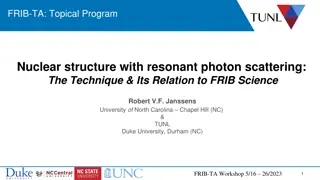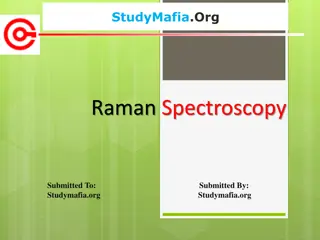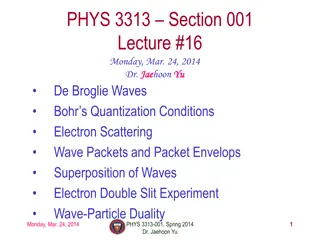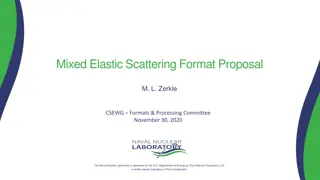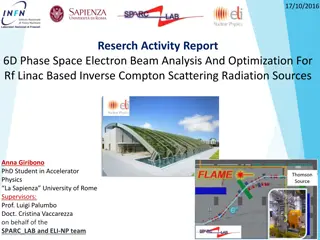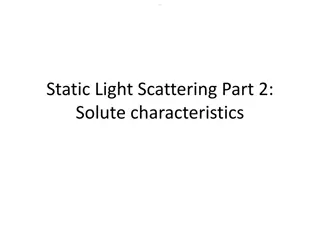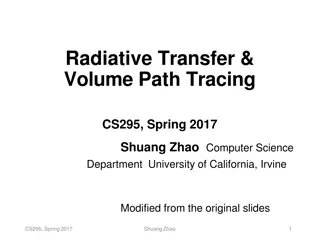Understanding Scattering Phenomenon: Key Concepts and Applications
Scattering is a fundamental process involving the interaction of light with particles, impacting various fields such as physics and environmental science. Learn about its measurement theory, dependence on physical properties, and examples like Rayleigh theory for small particle scattering and impacts on water density inhomogeneities. Explore the significance of optical properties and implications for different types of particles.
Download Presentation

Please find below an Image/Link to download the presentation.
The content on the website is provided AS IS for your information and personal use only. It may not be sold, licensed, or shared on other websites without obtaining consent from the author. Download presentation by click this link. If you encounter any issues during the download, it is possible that the publisher has removed the file from their server.
E N D
Presentation Transcript
Scattering: What is it? Who does it? A few demos to get us going Why should you care about it? *includes materials by C. Roesler and C. Mobley
Scattering Measurement Theory b = fractional scatterance per unit distance b Scattered Radiant Flux a o t b = (-1/x)ln [ t / o] (-1/x)ln [ a / o] = c - a
Dimensionally, what should scattering dependent on? When dealing with a single particles, presented as: Ratio of optical cross section / Geometrical cross section (non-dimensional) Size (cross-section, volume) Index of refraction (difference with medium) Wavelength (in medium) To get back to scattering units [m-1]: Optical cross section x concentration of particles
What physical properties determine the optical properties of particles? Size, composition (refractive index), shape, internal structure. These properties interact
Small Particle Scattering follows Rayleigh Theory Example for water ~ -4 ( ) b( ) VSF 0 30 60 90 120 150 180 400 500 600 700 Wavelength (nm) Similar results for viruses (Balch et al. 2000)
Scattering by water Density inhomogeneities: Water clusters Water clusters with salt Phase function: symmetric and similar to Rayleigh (D<< ): 1 ( ) ( ) + 2 1 cos + 1 Spectral dependence: Unlike Rayleigh ~ -4.32(e.g. Morel, 1974) Salts: increase scattering (~30% for 37psu). Weaker dependence on Temperature and Pressure. Latest works X. Zhang and co., Optics Express 2009.
Scattering by CDOM: Scattering by molecules whose D<< Rayleigh scattering: ( ) ( 1+ ) ( ) ( ) 4 b 2 cos No evidence in the literature that scattering is significant (the only place I have ever found significant dissolved scattering (cg>ag) was in pore water).
Large Particle Scattering Three effects: refraction, reflection and diffraction
refraction Changes the speed of propagation leading to directional changes and phase changes
Backscattering and scattering sensitivity to size: Boss et al., 2004, TOS Based on Mie theory (homogeneous spheres)
() response to particle size distribution First let s talk about particle size distributions r-3 r-5 Stramski and Kiefer 1989
() and response to particle size distribution ( ) / Vp Roesler and Boss, 2008
() response to index of refraction ( ) / Vp Roesler and Boss, 2008
What scatters in the oceans: Light within the ocean is scattered by: H2O+salts Colloids Inorganic particles Organic particles (bacteria, phytoplankton) bubbles
What particles scatter in the ocean? Phytoplankton: Variable in shape, size and pigment composition. Variable in scattering and absorption properties
What particles scatter in the ocean? Non-algal particles: Organic and inorganic. Sand Silt clay Aggregates: http://www.aad.gov.au/default.asp Variable in scattering and absorption properties
The bb enigma: Morel and Ahn, 1991: Algal cells in open ocean, and to lesser extent small heterotrophs, dominate the scattering coefficients; On the contrary, these organisms are definitely insignificant contributors to the backscattering coefficient. Stramski et al., 2001: simulating open-ocean (oligotrophic, 0.18mg Chl/m3) 2-3% of the backscattering coefficient is due to plankton. 50% from particles <0.2 m. Stramski et al., 2001
Phase functions: Stramski et al., 2001
The bb enigma (or paradox): Based on Mie theory, backscattering should be dominated by inorganic particles and sub-micron particles (the least known of the bunch). Yet bbp correlates well with [chl] and POC (>0.7 m): Stramski et al., 2008 Huot et al., 2008
Shape matters: VSF of large particles depends on <G>. From Clavano et al., 2007
Shape approximations for light scattering calculations Mie-Theory T-matrix Moderate Axis ratios (0.5<AR<2) 10 oblate 2 1 0.5 T-matrix Axis ratios up to convergence limit prolate 0.1 0.1 1 10 Particle radius ( m) Slide From Volten
An other approach, Coated spheres: Relative intensity Backscattering dominated by membrane. Meyer, 1979
Measurements across the equatorial Pacific (Dall olmo et al., 2009): bbp well correlated with cp bbp(D<0.2mm) bbp(D>0.2mm) No filter effect visible <0.1 Uncertainty dominated by uncertainty in bb(H2O)
Angular scattering: d Scattered Radiance Ls Lo Lt Incident Radiance Transmitted Radiance Volume scattering function [m-1sr-1]: x ( ( ) ) 1 L ( ) lim lim s s 0 0 i s x x L Most often assume azymuthal isotropy (only dependence). 0 i
Volume Scattering Function () ( ) = (-1/x d )ln[ b( )/ o] detector b/ source a o
Back-Scattering Measurements ( ) = (-1/x d )ln[ b( )/ o] Detected flux measurement must correct for attenuated flux along pathlength inner-filter effect x Define shape of detection area Calibration with known substance mathematically b ( ) o source detector
Scattering by phytoplankton In cultures (watch out for NAP) bb+Fchl Whitmire et al., 2010 Comparison with Mie theory of Stramski et al., 2001
Using one angle to infer backscattering 2 bp b = ( ) 0, 0 p p Consistency from 90->150degrees (except for one study ). Sullivan and Twardowski (2009):
Another commercial design: Eco-VSF Fit a 3rd order polynomial of sin( ) including at = . Integrate from to . Nominal angles: 104, 131, 151degrees
New designs to measure backscattering: Independent of VSF !!! Haubrich et al., 2011, Applied Optics Gainusa-Bogdan and Boss, 2011
Whitmire et al. (2010): Phytoplankton cultures (5 ): ( ) b = 2 0, 0 bp p p
Scattering by bubbles: Phase function of a population of bubbles: Clean With surfactant Theory (clean) Zhang et al., 2002, L&O
Scattering by aggregates (and what happen with handling) Aggregates: Boss et al., 2009 For particles with D>> : When scattering centers are far enough, IOPs are additive. Optical properties cross-sectional area, additive Depends on aggregate packaging ( fractal dimension). Spectral dependence of scattering
Summary: 1. Scattering measurements are useful but are not trivial. 2. Beware of models 3. There still is no consensus about what dominates backscattering -> ocean color.



